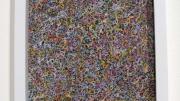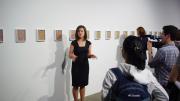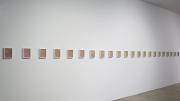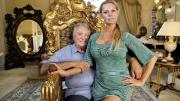Jennifer Quick, a Ph.D. candidate in the department of the history of art and architecture, stood before her audience in the main gallery of the Carpenter Center for the Visual Arts. Behind her, on a free-standing wall running down the middle of the gallery, hung more than a dozen works by Michael Wang ’03, a visual artist who creates micrograph images of artificially produced stem cells.
But as Quick began to lecture on Wang's works, another voice could be heard from behind the wall. It belonged to cellular biologist Gabriella Boulting, Ph.D. ’12, who was speaking to her own audience about pieces Wang had created that hung on her side of the wall.
Dueling gallery tours? Wang, an artist who aims to bring together art and science in interesting and thought-provoking ways, prefers to think of two lecturers working as one.
“I wanted to literally stage an encounter between two disciplines, the artistic community on one hand and the scientific on the other,” Wang says. “I don't think of artworks as ending with the individual artistic object. There is an expanded field that includes context and discourse around [that object] so I really wanted to make sure that could be an expanded part of the work. I wanted people from within the University to provide two very different insights at the exact same time.”
His latest work, Differentiation Series, is a sequence of micrograph images of artificially produced stem cells that have been hand-tinted using a system that matches a unique color to every specific cell type that can potentially be produced from these initially undifferentiated cells.
Interest in Boulting’s research on stem cells, specifically cellular differentiation, prompted Wang to begin traveling from his New York City home to Boston on weekends to follow her around the lab and observe her process (he learned of her work from her sister who works in a gallery in New York City). Boulting, who trained with professor of stem cell and regenerative biology Kevin Eggan, studies ‘induced pluripotent stem cells’, or iPS cells—adult cells that have been genetically reprogrammed to an embryonic stem cell-like state by being forced to express genes and factors important for maintaining the defining properties of embryonic stem cells.
“With these different kinds of recipes she was able to induce [stem] cells to become very specific types of cells,” Wang says. “There was something about her work that reconfigures how you think about humans that was really interesting to me—the idea that stem cells can turn into any cell. It was very intriguing.”
Around the time he met Boulting, Wang was asked to produce work for the lobby of the Carpenter Center and was in the midst of reading Space, Time, and Architecture by former Graduate School of Design professor and architecture critic Sigfried Giedion. The book describes Giedion’s interdisciplinary aspirations for the famous Le Corbusier building: “He really saw the Carpenter Center as a place where people would come from many different departments and disciplines and come together to do a kind of visual research,” Wang says.
The idea for Differentiations solidified when Wang began pondering the artistic correlation between cellular differentiation—the idea that stem cells can be induced to become any cell in the body—and the history of color theory. “I immediately thought of the history of color theory and Newton” he says, “in the sense that white light can produce any color on the spectrum. It seemed like a similar system.”
While thinking about how these two very different disciplines could be brought into alignment, Wang produced a pigment-mixing system that produced 411 colors—equal to the most comprehensive list of identified cell types in the adult human body—and deployed a color-coding system that he used to paint each individual cell by hand.
Comparing Wang’s work to that of French pointillist painter Georges Seurat at the opening of the exhibit, art historian Quick spoke about how both Seurat and Wang take scenes from life and filter them through a different lens to create a new meaning.
Wang’s “gesture is both intimate—working so closely with microscopic things—and grand—in that these things form the core of life,” Quick said during the opening of the exhibit. “It turns what look like illegible blobs into a coherent form, and moreover a form—material objects, with their own weight and presence—that both suggest what imagery of ‘life’ might look like now and help us to grasp how these images of life—how we picture what we know of the world—are always rapidly changing.”










